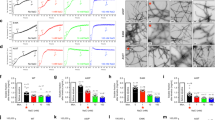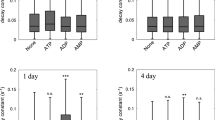Abstract
Amyloid-β amyloidogenesis is reported to occur via a nucleated polymerization mechanism. If this is true, the energetically unfavorable oligomeric nucleus should be very hard to detect. However, many laboratories have detected early nonfibrillar amyloid-β oligomers without observing amyloid fibrils, suggesting that a mechanistic revision may be needed. Here we introduce Cys-Cys-amyloid-β1–40, which cannot bind to the latent fluorophore FlAsH as a monomer, but can bind FlAsH as an nonfibrillar oligomer or as a fibril, rendering the conjugates fluorescent. Through FlAsH monitoring of Cys-Cys-amyloid-β1–40 aggregation, we found that amyloid-β1–40 rapidly and efficiently forms spherical oligomers in vitro (85% yield) that are kinetically competent to slowly convert to amyloid fibrils by a nucleated conformational conversion mechanism. This methodology was used to show that plasmalogen ethanolamine vesicles eliminate the proteotoxicity-associated oligomerization phase of amyloid-β amyloidogenesis while allowing fibril formation, rationalizing how low concentrations of plasmalogen ethanolamine in the brain are epidemiologically linked to Alzheimer's disease.
This is a preview of subscription content, access via your institution
Access options
Subscribe to this journal
Receive 12 print issues and online access
$259.00 per year
only $21.58 per issue
Buy this article
- Purchase on Springer Link
- Instant access to full article PDF
Prices may be subject to local taxes which are calculated during checkout






Similar content being viewed by others
References
Selkoe, D.J. The molecular pathology of Alzheimer's disease. Neuron 6, 487–498 (1991).
Hardy, J. The Alzheimer family of diseases: many etiologies, one pathogenesis? Proc. Natl. Acad. Sci. USA 94, 2095–2097 (1997).
Holtzman, D.M., Morris, J.C. & Goate, A.M. Alzheimer's disease: the challenge of the second century. Sci. Transl. Med. 3, 77sr71 (2011).
Klein, W.L., Krafft, G.A. & Finch, C.E. Targeting small Aβ oligomers: the solution to an Alzheimer's disease conundrum? Trends Neurosci. 24, 219–224 (2001).
Walsh, D.M. & Selkoe, D.J. Aβ oligomers—a decade of discovery. J. Neurochem. 101, 1172–1184 (2007).
Shankar, G.M. et al. Amyloid-β protein dimers isolated directly from Alzheimer's brains impair synaptic plasticity and memory. Nat. Med. 14, 837–842 (2008).
Shoji, M. et al. Production of the Alzheimer amyloid β protein by normal proteolytic processing. Science 258, 126–129 (1992).
Garzon-Rodriguez, W., Sepulveda-Becerra, M., Milton, S. & Glabe, C.G. Soluble amyloid Aβ-(1–40) exists as a stable dimer at low concentrations. J. Biol. Chem. 272, 21037–21044 (1997).
Ono, K., Condron, M.M. & Teplow, D.B. Structure-neurotoxicity relationships of amyloid β-protein oligomers. Proc. Natl. Acad. Sci. USA 106, 14745–14750 (2009).
Bernstein, S.L. et al. Amyloid-β protein oligomerization and the importance of tetramers and dodecamers in the aetiology of Alzheimer's disease. Nat. Chem. 1, 326–331 (2009).
Lesné, S. et al. A specific amyloid-β protein assembly in the brain impairs memory. Nature 440, 352–357 (2006).
Lambert, M.P. et al. Diffusible, nonfibrillar ligands derived from Aβ1–42 are potent central nervous system neurotoxins. Proc. Natl. Acad. Sci. USA 95, 6448–6453 (1998).
Lomakin, A., Teplow, D.B., Kirschner, D.A. & Benedek, G.B. Kinetic theory of fibrillogenesis of amyloid-β protein. Proc. Natl. Acad. Sci. USA 94, 7942–7947 (1997).
Sabaté, R. & Estelrich, J. Evidence of the existence of micelles in the fibrillogenesis of β-amyloid peptide. J. Phys. Chem. B 109, 11027–11032 (2005).
Tomiyama, T. et al. A mouse model of amyloid β oligomers: their contribution to synaptic alteration, abnormal tau phosphorylation, glial activation, and neuronal loss in vivo. J. Neurosci. 30, 4845–4856 (2010).
Harper, J.D. & Lansbury, P.T. Jr. Models of amyloid seeding in Alzheimer's disease and scrapie: mechanistic truths and physiological consequences of the time-dependent solubility of amyloid proteins. Annu. Rev. Biochem. 66, 385–407 (1997).
Jarrett, J.T. & Lansbury, P.T. Jr. Seeding “one-dimensional crystallization” of amyloid: A pathogenic mechanism in Alzheimer's disease and scrapie? Cell 73, 1055–1058 (1993).
Roychaudhuri, R., Yang, M., Hoshi, M.M. & Teplow, D.B. Amyloid β-protein assembly and Alzheimer disease. J. Biol. Chem. 284, 4749–4753 (2009).
Wetzel, R. Kinetics and thermodynamics of amyloid fibril assembly. Acc. Chem. Res. 39, 671–679 (2006).
LeVine, H. III. Thioflavin T interaction with synthetic Alzheimer's disease β-amyloid peptides: detection of amyloid aggregation in solution. Protein Sci. 2, 404–410 (1993).
Bieschke, J., Zhang, Q., Powers, E.T., Lerner, R.A. & Kelly, J.W. Oxidative metabolites accelerate Alzheimer's amyloidogenesis by a two-step mechanism, eliminating the requirement for nucleation. Biochemistry 44, 4977–4983 (2005).
Kayed, R. et al. Common structure of soluble amyloid oligomers implies common mechanism of pathogenesis. Science 300, 486–489 (2003).
Griffin, B.A., Adams, S.R. & Tsien, R.Y. Specific covalent labeling of recombinant protein molecules inside live cells. Science 281, 269–272 (1998).
Coleman, B.M. et al. Conformational detection of prion protein with biarsenical labeling and FlAsH fluorescence. Biochem. Biophys. Res. Commun. 380, 564–568 (2009).
Luedtke, N.W., Dexter, R.J., Fried, D.B. & Schepartz, A. Surveying polypeptide and protein domain conformation and association with FlAsH and ReAsH. Nat. Chem. Biol. 3, 779–784 (2007).
Krishnan, B. & Gierasch, L.M. Cross-strand split tetra-Cys motifs as structure sensors in a β-sheet protein. Chem. Biol. 15, 1104–1115 (2008).
Goodman, J.L., Fried, D.B. & Schepartz, A. Bipartite tetracysteine display requires site flexibility for ReAsH coordination. ChemBioChem 10, 1644–1647 (2009).
Webber, T.M. et al. Conformational detection of p53's oligomeric state by FlAsH fluorescence. Biochem. Biophys. Res. Commun. 384, 66–70 (2009).
Petkova, A.T. et al. A structural model for Alzheimer's β-amyloid fibrils based on experimental constraints from solid state NMR. Proc. Natl. Acad. Sci. USA 99, 16742–16747 (2002).
Lührs, T. et al. 3D structure of Alzheimer's amyloid-β(1–42) fibrils. Proc. Natl. Acad. Sci. USA 102, 17342–17347 (2005).
Porat, Y., Abramowitz, A. & Gazit, E. Inhibition of amyloid fibril formation by polyphenols: structural similarity and aromatic interactions as a common inhibition mechanism. Chem. Biol. Drug Des. 67, 27–37 (2006).
Yang, F. et al. Curcumin inhibits formation of amyloid β oligomers and fibrils, binds plaques, and reduces amyloid in vivo. J. Biol. Chem. 280, 5892–5901 (2005).
Maezawa, I. et al. Congo red and thioflavin-T analogs detect Aβ oligomers. J. Neurochem. 104, 457–468 (2008).
Serio, T.R. et al. Nucleated conformational conversion and the replication of conformational information by a prion determinant. Science 289, 1317–1321 (2000).
Thakur, A.K. et al. Polyglutamine disruption of the huntingtin exon 1 N terminus triggers a complex aggregation mechanism. Nat. Struct. Mol. Biol. 16, 380–389 (2009).
Wei, L. et al. The molecular basis of distinct aggregation pathways of islet amyloid polypeptide. J. Biol. Chem. 286, 6291–6300 (2011).
Chimon, S. et al. Evidence of fibril-like β-sheet structures in a neurotoxic amyloid intermediate of Alzheimer's β-amyloid. Nat. Struct. Mol. Biol. 14, 1157–1164 (2007).
Ahmed, M. et al. Structural conversion of neurotoxic amyloid-β (1–42) oligomers to fibrils. Nat. Struct. Mol. Biol. 17, 561–567 (2010).
Nilsberth, C. et al. The 'Arctic' APP mutation (E693G) causes Alzheimer's disease by enhanced Aβ protofibril formation. Nat. Neurosci. 4, 887–893 (2001).
Lashuel, H.A. et al. Mixtures of wild-type and a pathogenic (E22G) form of Aβ40 in vitro accumulate protofibrils, including amyloid pores. J. Mol. Biol. 332, 795–808 (2003).
Tomiyama, T. et al. A new amyloid β variant favoring oligomerization in Alzheimer's-type dementia. Ann. Neurol. 63, 377–387 (2008).
Cloe, A.L., Orgel, J.P., Sachleben, J.R., Tycko, R. & Meredith, S.C. The Japanese mutant Aβ(ΔE22-Aβ1–39) forms fibrils instantaneously, with low-thioflavin T fluorescence: seeding of wild-type Aβ1–40 into atypical fibrils by ΔE22-Aβ1–39 . Biochemistry 50, 2026–2039 (2011).
Wells, K., Farooqui, A.A., Liss, L. & Horrocks, L.A. Neural membrane phospholipids in Alzheimer disease. Neurochem. Res. 20, 1329–1333 (1995).
Goodenowe, D.B. et al. Peripheral ethanolamine plasmalogen deficiency: a logical causative factor in Alzheimer's disease and dementia. J. Lipid Res. 48, 2485–2498 (2007).
Han, X., Holtzman, D.M. & McKeel, D.W. Jr. Plasmalogen deficiency in early Alzheimer's disease subjects and in animal models: molecular characterization using electrospray ionization mass spectrometry. J. Neurochem. 77, 1168–1180 (2001).
Martins, I.C. et al. Lipids revert inert Aβ amyloid fibrils to neurotoxic protofibrils that affect learning in mice. EMBO J. 27, 224–233 (2008).
Kim, S., Nollen, E.A., Kitagawa, K., Bindokas, V.P. & Morimoto, R.I. Polyglutamine protein aggregates are dynamic. Nat. Cell Biol. 4, 826–831 (2002).
Outeiro, T.F. et al. Formation of toxic oligomeric α-synuclein species in living cells. PLoS One 3, e1867 (2008).
Yushchenko, D.A., Fauerbach, J.A., Thirunavukkuarasu, S., Jares-Erijman, E.A. & Jovin, T.M. Fluorescent ratiometric MFC probe sensitive to early stages of α-synuclein aggregation. J. Am. Chem. Soc. 132, 7860–7861 (2010).
Roberti, M.J., Bertoncini, C.W., Klement, R., Jares-Erijman, E.A. & Jovin, T.M. Fluorescence imaging of amyloid formation in living cells by a functional, tetracysteine-tagged α-synuclein. Nat. Methods 4, 345–351 (2007).
Sunde, M. & Blake, C. The structure of amyloid fibrils by electron microscopy and X-ray diffraction. Adv. Protein Chem. 50, 123–159 (1997).
Acknowledgements
We thank the US National Institutes of Health (NS050636), The Skaggs Institute for Chemical Biology and the Lita Annenberg Hazen Foundation for financial support and C. Fearns for critical feedback on the manuscript.
Author information
Authors and Affiliations
Contributions
J.L. designed and carried out experiments, analyzed data and wrote the paper. E.K.C. carried out experiments and wrote the paper. E.T.P. and J.W.K. designed experiments, analyzed data and wrote the paper.
Corresponding author
Ethics declarations
Competing interests
J.W.K. is a cofounder, paid consultant and a shareholder of FoldRx Pharmaceuticals (Pfizer) and Proteostasis Therapeutics.
Supplementary information
Supplementary Text and Figures
Supplementary Methods and Supplementary Results (PDF 1220 kb)
Rights and permissions
About this article
Cite this article
Lee, J., Culyba, E., Powers, E. et al. Amyloid-β forms fibrils by nucleated conformational conversion of oligomers. Nat Chem Biol 7, 602–609 (2011). https://doi.org/10.1038/nchembio.624
Received:
Accepted:
Published:
Issue Date:
DOI: https://doi.org/10.1038/nchembio.624
This article is cited by
-
Propagation of tau and α-synuclein in the brain: therapeutic potential of the glymphatic system
Translational Neurodegeneration (2022)
-
Unconjugated PLGA nanoparticles attenuate temperature-dependent β-amyloid aggregation and protect neurons against toxicity: implications for Alzheimer’s disease pathology
Journal of Nanobiotechnology (2022)
-
Residue Interaction Network Analysis Predicts a Val24–Ile31 Interaction May be Involved in Preventing Amyloid‐Beta (1–42) Primary Nucleation
The Protein Journal (2021)
-
Mechanisms and therapeutic potential of interactions between human amyloids and viruses
Cellular and Molecular Life Sciences (2021)
-
Instantaneous fibrillation of egg white proteome with ionic liquid and macromolecular crowding
Communications Materials (2020)



